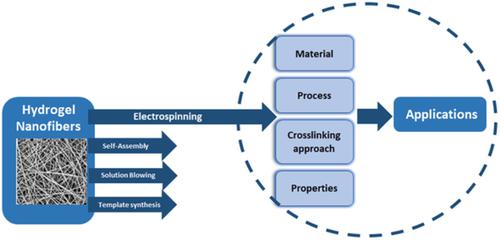当前位置:
X-MOL 学术
›
Polym. Eng. Sci.
›
论文详情
Our official English website, www.x-mol.net, welcomes your
feedback! (Note: you will need to create a separate account there.)
Review of electrospun hydrogel nanofiber system: Synthesis, Properties and Applications
Polymer Engineering and Science ( IF 3.2 ) Pub Date : 2021-05-13 , DOI: 10.1002/pen.25709 Tanushree Ghosh 1 , Trisha Das 1 , Roli Purwar 1
Polymer Engineering and Science ( IF 3.2 ) Pub Date : 2021-05-13 , DOI: 10.1002/pen.25709 Tanushree Ghosh 1 , Trisha Das 1 , Roli Purwar 1
Affiliation

|
Hydrogel-based nanofibers or vice versa are a relatively new class of nanomaterials, in which hydrogels are structured in nanofibrous form. Structure and size of the material directly governs its functionality, therefore, in hydrogel science, the nanofibrous form of hydrogels enables its usage in targeted applications. Hydrogel nanofiber system combines the desirable properties of both hydrogel and nanofiber like flexibility, soft consistency, elasticity, and biocompatibility due to high water content, large surface area to volume ratio, low density, small pore size and interconnected pores, high stiffness, tensile strength, and surface functionality. Swelling behavior is a critical property of hydrogels that is significantly increased in hydrogel nanofibers due to their small size. Electrospinning is the most popular method to fabricate “hydrogel nanofibers,” while other processes like self-assembly, solution blowing and template synthesis also exist. Merging the characteristics of both hydrogels and nanofibers in one system allows applications in drug delivery, tissue engineering, actuation, wound dressing, photoluminescence, light-addressable potentiometric sensor (LAPS), waterproof breathable membranes, and enzymatic immobilization. Treatment of wastewater, detection, and adsorption of metal ions are also emerging applications. In this review paper, we intend to summarize in detail about electrospun “hydrogel nanofiber” in relation to its synthesis, properties, and applications.
中文翻译:

电纺水凝胶纳米纤维系统综述:合成、性能和应用
基于水凝胶的纳米纤维(反之亦然)是一类相对较新的纳米材料,其中水凝胶以纳米纤维形式构造。材料的结构和尺寸直接控制其功能,因此,在水凝胶科学中,水凝胶的纳米纤维形式使其能够用于目标应用。水凝胶纳米纤维系统结合了水凝胶和纳米纤维的理想特性,如柔韧性、柔软稠度、弹性和生物相容性,因为含水量高、表面积与体积比大、密度低、孔径小和互连孔、高刚度、抗拉强度, 和表面功能。溶胀行为是水凝胶的一个关键特性,由于其尺寸小,水凝胶纳米纤维的溶胀行为显着增加。静电纺丝是制造“水凝胶纳米纤维”最流行的方法,而其他工艺如自组装、溶液吹塑和模板合成也存在。将水凝胶和纳米纤维的特性合并在一个系统中,可以应用于药物输送、组织工程、驱动、伤口敷料、光致发光、光寻址电位传感器 (LAPS)、防水透气膜和酶固定化。废水的处理、金属离子的检测和吸附也是新兴的应用。在这篇综述论文中,我们打算详细总结电纺“水凝胶纳米纤维”的合成、性能和应用。将水凝胶和纳米纤维的特性合并在一个系统中,可以应用于药物输送、组织工程、驱动、伤口敷料、光致发光、光寻址电位传感器 (LAPS)、防水透气膜和酶固定化。废水的处理、金属离子的检测和吸附也是新兴的应用。在这篇综述论文中,我们打算详细总结电纺“水凝胶纳米纤维”的合成、性能和应用。将水凝胶和纳米纤维的特性合并在一个系统中,可以应用于药物输送、组织工程、驱动、伤口敷料、光致发光、光寻址电位传感器 (LAPS)、防水透气膜和酶固定化。废水的处理、金属离子的检测和吸附也是新兴的应用。在这篇综述论文中,我们打算详细总结电纺“水凝胶纳米纤维”的合成、性能和应用。和吸附金属离子也是新兴的应用。在这篇综述论文中,我们打算详细总结电纺“水凝胶纳米纤维”的合成、性能和应用。和吸附金属离子也是新兴的应用。在这篇综述论文中,我们打算详细总结电纺“水凝胶纳米纤维”的合成、性能和应用。
更新日期:2021-07-09
中文翻译:

电纺水凝胶纳米纤维系统综述:合成、性能和应用
基于水凝胶的纳米纤维(反之亦然)是一类相对较新的纳米材料,其中水凝胶以纳米纤维形式构造。材料的结构和尺寸直接控制其功能,因此,在水凝胶科学中,水凝胶的纳米纤维形式使其能够用于目标应用。水凝胶纳米纤维系统结合了水凝胶和纳米纤维的理想特性,如柔韧性、柔软稠度、弹性和生物相容性,因为含水量高、表面积与体积比大、密度低、孔径小和互连孔、高刚度、抗拉强度, 和表面功能。溶胀行为是水凝胶的一个关键特性,由于其尺寸小,水凝胶纳米纤维的溶胀行为显着增加。静电纺丝是制造“水凝胶纳米纤维”最流行的方法,而其他工艺如自组装、溶液吹塑和模板合成也存在。将水凝胶和纳米纤维的特性合并在一个系统中,可以应用于药物输送、组织工程、驱动、伤口敷料、光致发光、光寻址电位传感器 (LAPS)、防水透气膜和酶固定化。废水的处理、金属离子的检测和吸附也是新兴的应用。在这篇综述论文中,我们打算详细总结电纺“水凝胶纳米纤维”的合成、性能和应用。将水凝胶和纳米纤维的特性合并在一个系统中,可以应用于药物输送、组织工程、驱动、伤口敷料、光致发光、光寻址电位传感器 (LAPS)、防水透气膜和酶固定化。废水的处理、金属离子的检测和吸附也是新兴的应用。在这篇综述论文中,我们打算详细总结电纺“水凝胶纳米纤维”的合成、性能和应用。将水凝胶和纳米纤维的特性合并在一个系统中,可以应用于药物输送、组织工程、驱动、伤口敷料、光致发光、光寻址电位传感器 (LAPS)、防水透气膜和酶固定化。废水的处理、金属离子的检测和吸附也是新兴的应用。在这篇综述论文中,我们打算详细总结电纺“水凝胶纳米纤维”的合成、性能和应用。和吸附金属离子也是新兴的应用。在这篇综述论文中,我们打算详细总结电纺“水凝胶纳米纤维”的合成、性能和应用。和吸附金属离子也是新兴的应用。在这篇综述论文中,我们打算详细总结电纺“水凝胶纳米纤维”的合成、性能和应用。










































 京公网安备 11010802027423号
京公网安备 11010802027423号